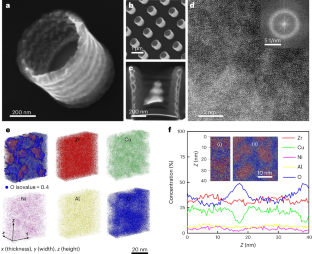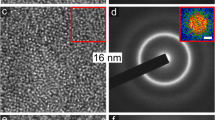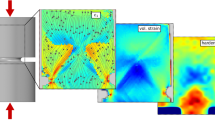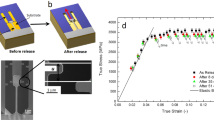Abstract
Although metallic nanostructures have been attracting tremendous research interest in nanoscience and nanotechnologies, it is known that environmental attacks, such as surface oxidation, can easily initiate cracking on the surface of metals, thus deteriorating their overall functional/structural properties1,2,3. In sharp contrast, here we report that severely oxidized metallic glass nanotubes can attain an ultrahigh recoverable elastic strain of up to ~14% at room temperature, which outperform bulk metallic glasses, metallic glass nanowires and many other superelastic metals hitherto reported. Through in situ experiments and atomistic simulations, we reveal that the physical mechanisms underpinning the observed superelasticity can be attributed to the formation of a percolating oxide network in metallic glass nanotubes, which not only restricts atomic-scale plastic events during loading but also leads to the recovery of elastic rigidity on unloading. Our discovery implies that oxidation in low-dimensional metallic glasses can result in unique properties for applications in nanodevices.
This is a preview of subscription content, access via your institution
Access options
Access Nature and 54 other Nature Portfolio journals
Get Nature+, our best-value online-access subscription
$29.99 / 30 days
cancel any time
Subscribe to this journal
Receive 12 print issues and online access
$259.00 per year
only $21.58 per issue
Buy this article
- Purchase on Springer Link
- Instant access to full article PDF
Prices may be subject to local taxes which are calculated during checkout



Similar content being viewed by others
Data availability
The datasets used or analysed during the current study are available from the corresponding authors on reasonable request.
References
Cabrera, N. & Mott, N. F. Theory of the oxidation of metals. Rep. Prog. Phys. 12, 163–184 (1949).
Boyce, B. L., Michael, J. R. & Kotula, P. G. Fatigue of metallic microdevices and the role of fatigue-induced surface oxides. Acta Mater. 52, 1609–1619 (2004).
Barrios, A., Gupta, S., Castelluccio, G. M. & Pierron, O. N. Quantitative in situ SEM high cycle fatigue: the critical role of oxygen on nanoscale-void-controlled nucleation and propagation of small cracks in Ni microbeams. Nano Lett. 18, 2595–2602 (2018).
Chen, Y. et al. Two-dimensional metal nanomaterials: synthesis, properties, and applications. Chem. Rev. 118, 6409–6455 (2018).
Ruck, M. At the edge of covalency: metallic nanotubes, low-dimensional metals and clusters. Z. Kristallogr. Cryst. Mater. 225, 167–172 (2010).
Wang, T., Park, M., Yu, Q., Zhang, J. & Yang, Y. Stability and synthesis of 2D metals and alloys: a review. Mater. Today Adv. 8, 100092 (2020).
Schaedler, T. A. et al. Ultralight metallic microlattices. Science 334, 962–965 (2011).
Lee, S.-W., Jafary-Zadeh, M., Chen, D. Z., Zhang, Y.-W. & Greer, J. R. Size effect suppresses brittle failure in hollow Cu60Zr40 metallic glass nanolattices deformed at cryogenic temperatures. Nano Lett. 15, 5673–5681 (2015).
Maloney, K. J. et al. Microlattices as architected thin films: analysis of mechanical properties and high strain elastic recovery. APL Mater. 1, 022106 (2013).
Schroers, J. Processing of bulk metallic glass. Adv. Mater. 22, 1566–1597 (2010).
Duan, G. et al. Bulk metallic glass with benchmark thermoplastic processability. Adv. Mater. 19, 4272 (2007).
Kumar, G., Tang, H. X. & Schroers, J. Nanomoulding with amorphous metals. Nature 457, 868–872 (2009).
Li, J., Doubek, G., McMillon-Brown, L. & Taylor, A. D. Recent advances in metallic glass nanostructures: synthesis strategies and electrocatalytic applications. Adv. Mater. 31, 1802120 (2019).
Jang, D., Meza, L. R., Greer, F. & Greer, J. R. Fabrication and deformation of three-dimensional hollow ceramic nanostructures. Nat. Mater. 12, 893–898 (2013).
Johnson, W. L. & Samwer, K. A universal criterion for plastic yielding of metallic glasses with a (T/Tg)2/3 temperature dependence. Phys. Rev. Lett. 95, 195501 (2005).
Tian, L. et al. Approaching the ideal elastic limit of metallic glasses. Nat. Commun. 3, 609 (2012).
Jiang, Q. K. et al. The effect of size on the elastic strain limit in Ni60Nb40 glassy films. Acta Mater. 61, 4689–4695 (2013).
He, Q. F. et al. A highly distorted ultraelastic chemically complex Elinvar alloy. Nature 602, 251–257 (2022).
Saito, T. et al. Multifunctional alloys obtained via a dislocation-free plastic deformation mechanism. Science 300, 464–467 (2003).
Juan, J. S., Nó, M. L. & Schuh, C. A. Nanoscale shape-memory alloys for ultrahigh mechanical damping. Nat. Nanotechnol. 4, 415–419 (2009).
Zhang, J. et al. Achieving 5.9% elastic strain in kilograms of metallic glasses: nanoscopic strain engineering goes macro. Mater. Today 37, 18–26 (2020).
Hao, S. et al. A transforming metal nanocomposite with large elastic strain, low modulus, and high strength. Science 339, 1191–1194 (2013).
Chen, J.-K., Chen, W.-T., Cheng, C.-C., Yu, C.-C. & Chu, J. P. Metallic glass nanotube arrays: preparation and surface characterizations. Mater. Today 21, 178–185 (2018).
Chen, W.-T., Li, S.-S., Chu, J. P., Feng, K. C. & Chen, J.-K. Fabrication of ordered metallic glass nanotube arrays for label-free biosensing with diffractive reflectance. Biosens. Bioelectron. 102, 129–135 (2018).
Wang, C., Jones, R. L., Lin, E. K., Wu, W.-L. & Leu, J. Small angle X-ray scattering measurements of lithographic patterns with sidewall roughness from vertical standing waves. Appl. Phys. Lett. 90, 193122 (2007).
Ye, J. C., Lu, J., Liu, C. T., Wang, Q. & Yang, Y. Atomistic free-volume zones and inelastic deformation of metallic glasses. Nat. Mater. 9, 619–623 (2010).
Zhao, M. & Li, M. Comparative study of elastoplastic constitutive models for deformation of metallic glasses. Metals 2, 488–507 (2012).
Gao, Y. F., Yang, B. & Nieh, T. G. Thermomechanical instability analysis of inhomogeneous deformation in amorphous alloys. Acta Mater. 55, 2319–2327 (2007).
Zhang, J. et al. Strong yet ductile high entropy alloy derived nanostructured cermet. Nano Lett. 22, 7370–7377 (2022).
Albert, R., Jeong, H. & Barabási, A.-L. Error and attack tolerance of complex networks. Nature 406, 378–382 (2000).
Sajadi, S. M. et al. Damage-tolerant 3D-printed ceramics via conformal coating. Sci. Adv. 7, eabc5028 (2021).
Matovic, J. & Jakšić, Z. Nanomebrane: a new MEMS/NEMS building block. in Micro Electronic and Mechanical Systems 61–84 (Books on Demand, 2009).
Wang, T. et al. The controlled large-area synthesis of two dimensional metals. Mater. Today 36, 30–39 (2020).
Yu, Q. et al. Strong, ductile, and tough nanocrystal-assembled freestanding gold nanosheets. Nano Lett. 22, 822–829 (2022).
Cahn, J. W. & Hilliard, J. E. Free energy of a nonuniform system. I. Interfacial free energy. J. Chem. Phys. 28, 258–267 (1958).
Su, R. et al. Models and algorithms towards the metallic glasses vitrification at deep supercooled region. Preprint at arXiv https://doi.org/10.48550/arXiv.2211.03350 (2023).
Thompson, A. P. et al. LAMMPS—a flexible simulation tool for particle-based materials modeling at the atomic, meso, and continuum scales. Comput. Phys. Commun. 271, 108171 (2022).
Parrinello, M. & Rahman, A. Polymorphic transitions in single crystals: a new molecular dynamics method. J. Appl. Phys. 52, 7182–7190 (1981).
Hu, Y. C. et al. Unveiling atomic-scale features of inherent heterogeneity in metallic glass by molecular dynamics simulations. Phys. Rev. B 93, 214202 (2016).
Falk, M. L. & Langer, J. S. Dynamics of viscoplastic deformation in amorphous solids. Phys. Rev. E 57, 7192–7205 (1998).
Acknowledgements
The research of Y.Y. is supported by the research grant council (RGC), the Hong Kong government, through the general research fund (GRF) with grant nos. N_CityU 109/21, CityU11200719 and CityU11213118. P.F.G. acknowledges support from the NSF of China (grant nos. 5211101002, 12088101 and U2230402). We acknowledge computational support from the Beijing Computational Science Research Center (CSRC). Y.H.L. acknowledges support from the National Natural Science Foundation of China (grant no. 51825104). F.L. acknowledges support from the China Postdoctoral Science Foundation (grant no. 2020TQ0346); Guangdong Major Project of Basic and Applied Basic Research, China (grant no. 2019B030302010); and the National Natural Science Foundation of China (grant no. 52201195). Y.L. acknowledges support from RGC under RFS2021-1S05. J.W. acknowledges support from the NSF of China (grant no. 52071081).
Author information
Authors and Affiliations
Contributions
Y.Y. supervised the project. Y.Y., Y.H.L. and P.G. conceived the idea. N.B., T.C. and J.P.C. fabricated the MG nanotubes. Z.Z. fabricated the MG nanosheets. F.L. performed the TEM characterization. F.L. and J.L. carried out the 3D-APT characterization. F.L., X.F. and H.Z. performed the in situ microcompression. Z.Z. performed the AFM characterization. H.L. performed the atomistic simulations. W.Z., Z.Z., T.W. and M.P. performed the FEM simulations. J.Z. carried out the digital image correlation analysis. F.L., H.L., Z.Z., T.W., J.W., X.L., Y.L. Y.H.L., Y.Y. and P.G. contributed to the data analyses. F.L., H.L., Z.Z., P.G. and Y.Y. wrote the manuscript.
Corresponding authors
Ethics declarations
Competing interests
The authors declare no competing interests.
Peer review
Peer review information
Nature Materials thanks Mehdi Jafary-Zadeh, Gang Sha and Sang Ho Oh for their contribution to the peer review of this work.
Additional information
Publisher’s note Springer Nature remains neutral with regard to jurisdictional claims in published maps and institutional affiliations.
Extended data
Extended Data Fig. 1 The characterization of the wavy structure of a metallic-glass nanotube.
The wave-like profile extracted from the vertical-sectional view (the inset) of a ZrCuAlNi(O) metallic-glass nanotube, which can be fitted well to a sinusoidal function.
Extended Data Fig. 2 The compositional characterization of the ZrCuAlNi metallic-glass nanotube.
a. The Schematic diagram illustrating the different view directions for structural observation, b. EELS mapping of different elements from the side view of nanotubes, c. EELS mapping of different elements from the cross-sectional view of nanotubes.
Extended Data Fig. 3 Mechanical characterization of NiSiCrFeB(O) metallic-glass nanotubes.
a. A nominal stress-strain curve of the NiSiCrFeB(O) metallic-glass nanotube under in-situ micro-compression subject to the strain rate of 0.06 S−1 and the maximum strain of 15.4%, b. The SEM images of the corresponding NiSiCrFeB(O) metallic-glass nanotube before and after microcompression, c. Effect of the maximum strain on the recoverable strain at the strain rate of 0.06 S−1 or 0.003 S−1. Note that the recoverable strains measured from image correlations were repeated five times for averaging and data are presented as mean values +/−SD. d. Comparison of the load-depth data obtained from the indenter tip displacement and image correlation.
Extended Data Fig. 4 The FE simulated mechanical behavior of wavy tubes subject to an eccentric load with varying angles of misalignment.
a. The mechanical behavior of the regular tubes at the misalignment angle of 0 to 10 degrees, b. The mechanical behavior of the wavy tubes with a straight profile at the misalignment angle of 0 to 10 degrees. Both insets show the plastically deformed tubes that follow the conventional Drucker-Prager yield criterion.
Extended Data Fig. 5 Fitting of the experimental data to the elastic FE simulations for both ZrCuNiAl(O) and NiSiCrFeB(O) metallic-glass nanotubes.
a. FEM fitting of the elastic modulus for both ZrCuNiAl(O) and NiSiCrFeB(O) metallic-glass nanotubes. The insect = the wavy profile with thickness = 15 nm, wavelength = 80 nm, and amplitude = 5 nm, b. FEM fitting of the elastic modulus for both ZrCuNiAl(O) and NiSiCrFeB(O) metallic-glass nanotubes. The insect = the wavy profile with thickness = 25 nm, wavelength = 105 nm, and amplitude = 10 nm.
Extended Data Fig. 6 The effects of size and geometry of tubes on their elastic responses according to our FE simulations.
The effect of a. wall thickness, b. wave amplitude, and c. wavelength.
Extended Data Fig. 7 Atomistic model of O-containing samples.
Oxide network visualized by smooth surface meshes (yellow), referred to as a. ‘O-18%’. b. ‘model 1’, c. ‘model 2’ and d. ‘model 3’ samples with an alignment to the YZ plane for the sake of compressive loading simulations.
Extended Data Fig. 8 Plastic deformation of a metallic nature in ZrCu MG domains.
Distribution of \({D}^{2}\) in ZrCu MG domains calculated in the a. percolating (averaged in model 1 and 2) and b. non-percolating (model 3) samples.
Extended Data Fig. 9 Structural characteristics of the percolating (model 1, Co ~ 18%, solid lines) and non-percolating (model 3, Co ~ 17.5%, dashed lines) CuZr(O) models.
a. Total pair correlation function and b. partial pair correlation function.
Extended Data Fig. 10 Power law fitting of box-counting dimension.
Fractal dimensionality \({D}_{f}\) of the O-18% (red), model 1 (orange), model 2 (blue) and model 3 (green) samples computed by the counting box method. The straight lines are power fittings of box number from box size: \(N \sim {r}^{{-D}_{f}}\).
Supplementary information
Supplementary Information
Supplementary Figs. 1–10, Notes 1–4, Table 1, discussion and references.
Supplementary Video 1
In situ microcompression of a ZrCuAlNi(O) MG nanotube.
Supplementary Video 2
In situ microcompression of a NiSICrFeB(O) MG nanotube.
Rights and permissions
Springer Nature or its licensor (e.g. a society or other partner) holds exclusive rights to this article under a publishing agreement with the author(s) or other rightsholder(s); author self-archiving of the accepted manuscript version of this article is solely governed by the terms of such publishing agreement and applicable law.
About this article
Cite this article
Li, F., Zhang, Z., Liu, H. et al. Oxidation-induced superelasticity in metallic glass nanotubes. Nat. Mater. 23, 52–57 (2024). https://doi.org/10.1038/s41563-023-01733-8
Received:
Accepted:
Published:
Issue Date:
DOI: https://doi.org/10.1038/s41563-023-01733-8



